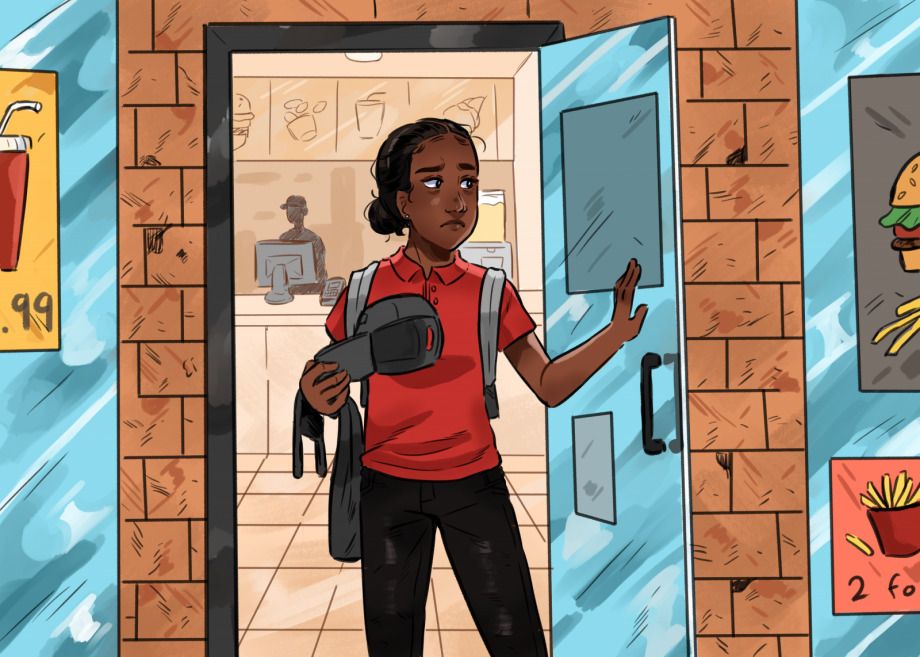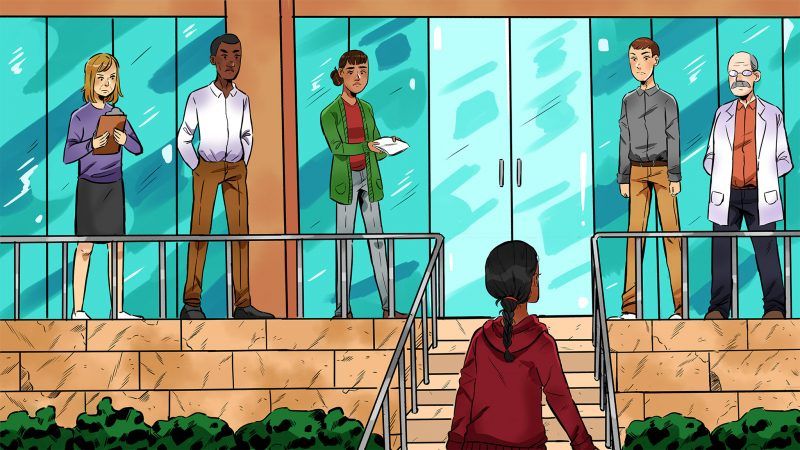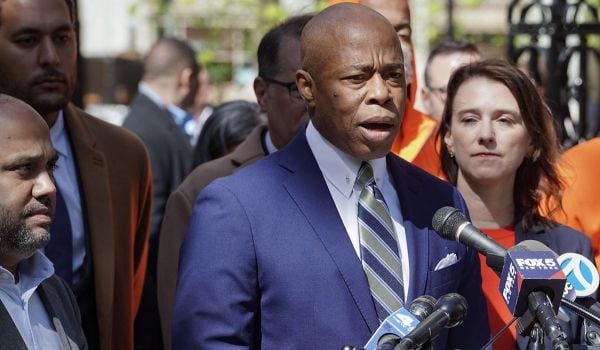EDITOR’S NOTE: This story is part of the “Our Kids” reporting project. Our Kids is a project of the Broke in Philly reporting collaborative that examines the challenges and opportunities facing Philadelphia’s foster care system.
By January of last year, then 19-year-old Miracle had spent months sleeping on friends’ couches, Philadelphia’s SEPTA lines and in abandoned cars, trying to find safe places to rest. When she found out she’d been accepted by a government-sponsored rapid rehousing program, her spirits rose. She made contact with a mentoring program for young writers, worked two jobs and started making plans.
“I feel great,” she said then, “like my life is really coming together.” The program name, Rapid Rehousing, suggests a greyhound, racing at top speed, fueling Miracle’s hopes. But rapid rehousing runs on just two legs. Miracle remained stuck in unsafe rooming arrangements and whatever temporary shelters she could find as days, weeks and months passed, until finally she couldn’t help but wonder if she’d make it at all. “It’s common,” says Rashni Stanford, a longtime Philadelphia youth activist and member of Philly Homes 4 Youth, a coalition of more than 30 advocacy groups and more than 40 young people who have experienced homelessness. She says delays are typical across numerous housing programs meant to provide quick assistance. “I’ve heard of people waiting up to a year after they’re enrolled in a program to find a home.” The long waits, though, are just one of the problems the Philly Homes 4 Youth coalition is targeting in a bid to make rapid rehousing live up to its name, seeking stability for the city’s young people at an age when most of their peers can take such security for granted. Miracle, who asked to be identified by this nickname to protect her privacy, described the long wait as a kind of cruel game of bait and switch, in which promising leads on a place to live continually led to dead ends. “A lot of landlords just weren’t going to rent to me, and my caseworker who was supposed to be helping me didn’t have a lot of suggestions,” she says. She’d call or even visit an apartment only to be refused. Miracle, 20, whose story was detailed in an earlier Next City article, entered her bout with homelessness in a way youth advocates describe as routine — fleeing from abusive situations at home and in foster care to try and find a better life. “No one wants to be homeless,” Miracle says. “I was just tired of being abused.” Each year, more than 20,000 young people across the nation age out of foster care, and more than 30% of them experience some period of homelessness. In Philadelphia, data released by Valley Youth House and Covenant House, which serve young people at risk of or experiencing homelessness, also suggest 36% to 46% of their clientele spent time in foster care. Research suggests that keeping youth out of homelessness or helping them into stable housing quickly bears great economic benefit to society, saving many millions of dollars in downstream costs associated with being placed at increased risk of homelessness, physical injury, mental health problems, unemployment, continued homelessness and crime. The methods we’ve established so far, however, of plugging young people into housing resources, don’t work particularly well — or sometimes at all. Researchers at the University of Southern California and Chapin Hall, a leading child and family well-being research organization at the University of Chicago, analyzed data from 10 homelessness systems around the country, discovering that only about 35% of young people accepted into a homelessness system are assisted into a new home. The average wait time, for those relatively lucky few who did receive housing, was four and a half months. “The waits are a big problem,” says Anne Farrell, director of research at Chapin Hall, “because it’s traumatic when you have no place to go and if you don’t have a stable home, it’s obviously hard to accomplish anything else.” Chapin Hall’s data also suggests that each day after entering a housing program that is spent without finding a home increases the likelihood of a future bout with homelessness by 2%. Research has also shown that most young adults continue to rely on their families for financial or housing support until they are at least 27 years old, enjoying the help and stability that youth in foster care seek. “I just needed some help,” Miracle says, “even a little of it. And it seemed like even the people who were saying they were going to help me, weren’t doing anything.” The details of Miracle’s story — reluctant landlords, helpers that weren’t actually helping — are also typical, but it turns out there are solutions that might give others like her the help they need. Late last spring, Miracle was enrolled in the rapid rehousing program administered through Valley Youth House (VYH) and funded by DHS, then told to scour rental listings. The program, innovated by VYH and lauded by the U.S. Department of Housing and Urban Development (HUD) in 2015 as a “promising practice,” allows would-be renters to seek out apartment listings, with VYH paying some or all the rent. (EDITOR’S NOTE: Rapid rehousing programs are usually funded through OHS.) The program’s innovations include putting the renter’s name on the lease. In older housing programs, the renter didn’t actually have their name on the lease at all, giving them no legal standing to extend their leases after the government’s support ended. Naming the renter as the leaseholder also helps them build a rental history to secure future housing.
Miracle, however, quickly felt lost. “I wasn’t sure where to look or who to call,” she says, because she wasn’t sure which landlords would give her an immediate “no.” Sometimes her housing caseworker at VYH gave her a tip on a listing and sometimes she found something that looked promising herself, only to call and find that the landlord was not willing to rent to someone her age or who is receiving government assistance. “I was beginning to feel hopeless,” Miracle said, as the months passed with no change. Philadelphia, like many cities, suffers from a deficit of affordable housing. Landlords are also notoriously reluctant to rent to young people with little or no credit history. Some fear renting to people who receive any kind of aid. In response, the federal Office of Housing and Urban Development has released a series of best practices and recommendations, including landlord recruitment and appreciation events focused on youth homelessness to create a pool of youth-friendly landlords; keeping a staff member on call during non-business hours to help resolve issues; and offering enlarged security deposits as protection. This spring, Los Angeles County moved to increase the rates available through monthly vouchers for young people leaving the foster care system, more than doubling the number of units available in transitional housing. Philly’s Valley Youth House has maintenance staff who can clean units left in disarray by VYH tenants and fix the damage—even, within limits, using flexible funding sources to pay for repairs when warranted. VYH is also running a pilot program of cash bonuses to incentivize landlords and shorten the time between intake and housing. Landlord recruitment, however, remains a grind, particularly in Philly, where a kind of gold rush around rent and real estate has been underway for many years. In a January letter to OHS, the Philly Homes 4 Youth Coalition (PH4Y) delivered a long list of suggested solutions and requests, including a program that would fund two full-time staff members to recruit and engage landlords, wooing them with signing bonuses, funds for repairs, landlord/tenant mediation services, and support and skills development for renters. The letter also asked that the city buy and develop more youth-specific housing on its own to circumvent the landlord problem entirely. The requests recalled one of OHS’s own documents, an April 2018 assessment describing an “unmet need” for 668 units of permanent or non-time-limited housing assistance for youth with the deepest needs; 622 units of time-limited housing, to help youth transitioning to independence; and an additional 394 units of preventive housing, to help young people at risk of homelessness. David Fair, a longtime family and youth services administrator and co-chair of the Philly Homes 4 Youth (PH4Y) coalition, says OHS officials didn’t indicate that they were ready to do anything PH4Y proposed. Fair says, “They did indicate they’ll be seeking feedback on what plans they do make,” Fair says, adding that they are building out plans for how to spend an influx of federal COVID relief funds. “In the past, they have said they want to develop more affordable housing projects for youth, but they have not found developers that were qualified and willing to help.” A city spokesperson said they encourage people to submit proposals for the COVID relief funds and have a “comprehensive landlord engagement strategy underway” to address youth housing needs, but said OHS did not have data available on how much housing is still needed for young adults. Last fall, several months after she’d been enrolled in the Rapid Rehousing program, Miracle’s housing caseworker left her a voicemail, saying he’d found a promising listing. She called back, immediately and repeatedly, only to get no return call. Believing that a stable home might just be a phone call away, only to receive no further information through two full weeks, was all she could take. She wound up, she admits, making some angry phone calls, or as she calls it, “MF’ing some people” at VYH. This led to her receiving a letter claiming she’d been non-compliant and informing her that she was being eliminated from the program. The entire episode reveals another flaw — and potential solutions — to the city’s services as they stand. According to Jessie Keel, a youth advocate, young people are often held to impossible standards by some of the caseworkers tasked with helping them. “These are people who have experienced some kind of trauma, and they just need someone to hold space for them and show some compassion,” she says. “And this is the caseworker’s job, but they take it personally, and they stop serving people sometimes or drag their feet.” As Keel puts it, “most young people are just learning their way, and they can make a mistake or mouth off to somebody or whatever, and it’s OK. But if you’re in one of these programs, you’re judged for that, so you have to be better than everyone else.” PH4Y also asked, in their January letter, for the hiring of more “youth navigators” or housing counselors to reduce their caseloads, enabling them to better serve their clients and reducing the prospects they’ll be “MF’d” in the future. They’ve also called for better training around working with younger people who might have endured past traumas. Helping organizations might also need to hold staff, and their own policies, more accountable to make sure they are trained to work with the young people they are in business to help. Keel says she has seen numerous people kicked out of government-assisted housing over relatively small amounts of money, $1,000 or so, in overdue payments. “They’re supposed to be aiding people who have nowhere else to go,” she says, “and they’re kicking them out over a small amount of rent.” Miracle, for her part, never even had a chance to miss rent, and now she was confronting her life anew, without even the hope of a slow-rehousing program — let alone a rapid one. “I don’t know what I’m going to do,” she said at the time. “I just don’t know and I am thinking, like, dark thoughts.” (Illustration by Dylan B. Caleho) Miracle fought off her own anxiety long enough to enlist the aid of her regular caseworker at VYH, who worked in a separate unit from her housing counselor. That caseworker advised her on how to write a letter of appeal, which Miracle submitted. The process took almost two weeks before she got the news: She was being reaccepted into the program. Then, she waited some more. Being in the housing program didn’t guarantee a house. Alyssa Weinfurtner, associate director at VYH, stepped in to serve as her housing counselor, and after another four months, a seven-month wait in total, Miracle finally found a home. There was no magic to it — an apartment became available, and the landlord was willing. Weinfurtner found it and Miracle called. “Alyssa really responded and was there for me,” Miracle says. “Whenever I called, I felt like she cared and that made a big difference. Having someone who hasn’t gone through what I’d gone through but still showed me they cared, really meant a lot. That little bit of support made a major difference in my life.” The question now, however, is how long this new home will last and whether Miracle can remain stably housed. In fact, while rapid rehousing often gets people into homes too slowly, it also gets them out too fast. “These programs don’t last very long,” says Farrell, from Chapin Hall. She says the rapid rehousing model was originally designed for adults. “These are often, if not usually, people with work histories and already in jobs, so it doesn’t take someone like that long to become self-sufficient.” Young people are at a different stage of life and development, just establishing their work and credit histories and understanding how to transition from dependence to self-sufficiency. Normally, young people who hit some kind of trouble can lean on relatives for help. A 2019 study showed that 70% of people in early adulthood, 18-34 years old, received some financial assistance from parents in the past year. More than half of those over 30 receive some regular form of support, and 58% said they couldn’t afford their “current lifestyle” without ongoing support. In a country that prides itself on a “bootstraps” mentality of rugged individualism, the data suggests most young adults, whether in or out of foster care, need financial help getting started in life. Youth coming out of foster care or simply without those kinds of family aids don’t have that benefit. So, moving into a home, with a year’s worth of rental assistance from the city, starts a clock ticking until the government program ends and they are without the family-based help that so many young people receive. In fact, when Miracle’s time in this current program ends she’ll be 21, at least six years younger than research shows the average young American achieves true self-sufficiency. Some researchers think the best way to handle this might be to give young people a very different kind of help, which doesn’t rely on a network of caseworkers or the set of rules under which most housing programs operate. “Direct cash assistance looks incredibly promising,” says Matthew Morton, a research fellow at Chapin Hall. Cash assistance programs are already a significant tool to provide help in other countries, with abundant research showing the money is spent on basic necessities, and just beginning to catch on here, including a pilot in Philadelphia for people who’ve previously received support through (TANF) Temporary Assistance for Needy Families. In July of last year, California lawmakers passed legislation providing $35 million in funding for direct cash assistance, sending monthly checks to pregnant women and youth transitioning out of foster care. Austin recently became one of two dozen American cities experimenting with some form of basic income payments, too, sending $1,000 per month to families in danger of losing their homes. Morton, at Chapin Hall, says such programs can be incredibly helpful to young people, allowing them to pay some rent to a relative or help with utilities, extending their stay, or moving in with a roommate who already has a lease, again circumventing the problem of reluctant landlords entirely. Miracle, who worked through most of her own experience of homelessness, says additional funds would have helped her. “I would have found affordable rent because I was also working part-time,” she says, “And I’d have been able to say at the end of the night, ‘I’m going home.’” Critics of direct cash assistance often claim the money will be wasted. But UpTogether, a California nonprofit that will run the Austin program, has been involved in direct income payments giving $1,000 per month, for a year, to 173 families, and just as research has shown in other countries, recipients have used the money for basic necessities, covering rent and mortgage payments, groceries and more. More than half of the recipients cut their debt by 75%, and more than a third eliminated their debt entirely. Morton is also leading a study in New York where young people receive enough money to pay their monthly rent in one of the outer boroughs. The study will generate more data on cash assistance programs in the United States. For the moment, in Philadelphia, Miracle is in a safe home, feeling her sense of hope and ambition restored, and thinking again about writing and other ambitions she harbors for her life and career. She is enrolled at the Community College of Philadelphia, finishing her high school diploma and earning college credits. “It feels amazing,” she says. “Like everything is possible again. When I didn’t have a place to live, to sleep, I couldn’t really think about anything else.”
Miracle’s Story
Navigating Landlords and Caseworkers
When the Helpers Harm

Finding a Home
This article is part of Backyard, a newsletter exploring scalable solutions to make housing fairer, more affordable and more environmentally sustainable. Subscribe to our weekly Backyard newsletter.

Steve Volk is a Stoneleigh Fellow and an investigative solutions reporter with Resolve Philly, a nonprofit journalism organization committed to collaboration, equity, and community voices and solutions. His work has appeared in Rolling Stone, Philadelphia, Discover and the Washington Post Sunday magazines.


















